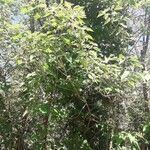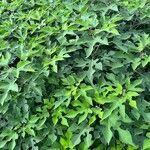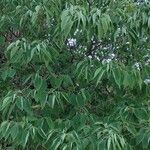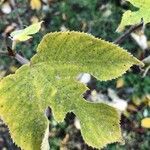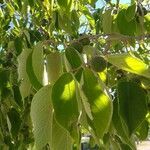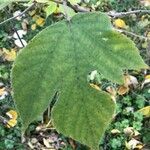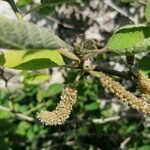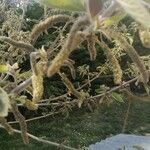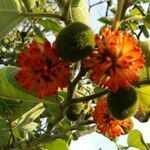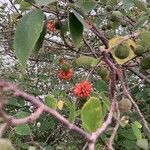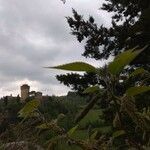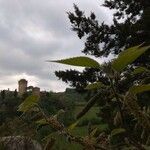Trees 10-20 m tall, flowers always produced on leafy stems; dioecious. Bark dark gray. Branchlets densely pubescent. Stipules ovate, 1.5-2 × 0.8-1 cm, apex attenuate. Leaves spirally arranged; petiole 2.3-8 cm; leaf blade broadly ovate to narrowly elliptic-ovate, simple or 3-5-lobed on young trees, 6-18 × 5-9 cm, abaxially densely pubescent but veins with coarser hairs, adaxially scabridulous and sparsely pubescent, base cordate and asymmetric, margin coarsely serrate, apex acuminate; secondary veins 6 or 7 on each side of midvein. Male inflorescences long spicate, 3-8 cm; bracts lanceolate, pubescent. Female inflorescences globose; bracts clavate, apically pubescent. Male flowers: calyx 4-lobed, lobes triangular-ovate and pubescent; anthers globose. Female flowers: calyx pipelike, lobes apically connate with style; ovary ovoid; stigma linear, pubescent. Syncarp orange-red when mature, 1.5-3 cm in diam., mostly pubescent with scattered stout and ± barbed hairs, fleshy. Drupelets equal in length to peduncle, with 2 rows of small verruca; exocarp shell-like. Fl. Apr-May, fr. Jun-Jul.
Trees , to 15 m. Bark tan, smooth or moderately furrowed. Branchlets brown, spreading pubescent. Terminal bud absent, axillary buds dark brown, short-pubescent; leaf scars nearly circular, somewhat elevated. Leaves: stipules ovate to ovate-oblong, apex attenuate; petiole shorter than or equal to blade. Leaf blade entire or 3-5-lobed, 6-20 × 5-15 cm, base shallowly cordate, often oblique, truncate, or broadly rounded, margins serrate, apex acuminate; surfaces abaxially densely gray-pubescent, adaxially scabrous. Staminate inflorescences 6-8 cm; peduncle 2-4 cm. Pistillate inflorescences ca. 2 cm diam., villous. Staminate flowers: sepals pubescent. Pistillate flowers: style elongate-filiform. Syncarps globose, 2-3 cm diam.; drupes red or orange, oblanceolate, each exserted from its calyx.
Tall shrub or small tree with smooth bark and pubescent twigs; lvs firm, broadly ovate, serrate and often lobed, scabrous above, densely pubescent beneath; staminate catkins slender, 5 cm; pistillate catkins 1–2 cm thick; fr 2–3 cm thick; 2n=26. Native of China and Japan, occasionally escaped from cult. from N.Y. to Mo. and s. Apr., May. (Papyrius p.)
